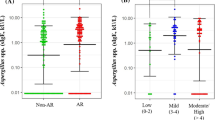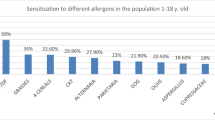Abstract
Background
The sensitization and exposure to fungal allergens have been reported to be associated with asthma. The aim of this study was to clarify the impact of sensitization to Schizophyllum commune (S. commune) on the severity and exacerbations of asthma.
Methods
Ninety-two patients with asthma of various levels of severity [mild (n = 18), moderate (28), and severe (46)] and exacerbation severity [moderate (n = 43) and severe (6)] were retrospectively examined with regard to fungal sensitization such as specific IgE or intradermal skin reactions against S. commune and other common allergens. We also classified the patients into three groups: (1) three or more asthma attacks during the past year (F-BA) (n = 29),(2) one or two asthma attacks (NF-BA) (n = 20), and (3) no asthma attack (C-BA) (n = 43).
Results
The positive rate of late cutaneous reactions to S. commune was higher in patients with severe asthma (41.2%) than with moderate (26.1%) or mild asthma (6.7%), and was significantly different among the three groups (P < 0.05). Although the ratio did not show a significant difference between the patients with severe (83.3%) or moderate (36.1%) exacerbation, it was higher in F-BA (60.9%) than in NF-BA (21.1%) and C-BA patients (10.0%), and it was significantly different among the three groups (P = 0.0002). Multivariate analysis identified positive results for late-phase skin reactions to S. commune and the age of the patients as an independent determinant of asthma severity, and the skin results and %FVC an independent determinant of exacerbation frequency.
Conclusion
This study demonstrated that S. commune is an environmental fungus that appears to enhance both the severity of asthma and the exacerbation frequency.
Similar content being viewed by others
References
Global Initiative for Asthma (GINA). Global strategy for asthma management and prevention, updated 2009. http://www.ginasthma.com. Accessed April 2011
Denning DW, O’Driscoll BR, Hogaboam CM, Bowyer P, Niven RM (2006) The link between fungi and severe asthma: a summary of the evidence. Eur Respir J 27(3):615–626
Black PN, Udy AA, Brodie SM (2000) Sensitivity to fungal allergens is a risk factor for life-threatening asthma. Allergy 55:501–504
Denning DW, O’Driscoll BR, Powell G, Chew F, Atherton GT, Vyas A (2009) Randomized controlled trial of oral antifungal treatment for severe asthma with fungal sensitization. Am J Respir Crit Care Med 179:11–18
Ogawa H, Fujimura M, Takeuchi Y, Makimura K (2009) Efficacy of itraconazole in the treatment of patients with chronic cough whose sputa yield basidiomycetous fungi—Fungus-associated chronic cough (FACC). J Asthma 46:407–411
Ogawa H, Fujimura M, Takeuchi Y, Makimura K (2009) The importance of basidiomycetous fungi cultured from the sputum of chronic idiopathic cough—a study to determine the existence of recognizable clinical patterns to distinguish CIC from non-CIC. Respir Med 103:1492–1497
Ogawa H, Fujimura M, Takeuchi Y, Makimura K (2009) Is Bjerkandera adusta important to fungus-associated chronic cough (FACC) as an allergen? Eight cases’ report. J Asthma 46:849–855
Helbling A, Brander KA, Horner WE, Lehrer SB (2002) Allergy to basidiomycetes. Chem Immunol 81:28–47
Ogawa H, Fujimura M, Takeuchi Y, Makimura K (2011) Two cases of Schizophyllum asthma: Is this a new clinical entity or a precursor of ABPM? Pulm Pharmacol Ther 24(5):559–562
Amitani R, Nishimura K, Niimi A, Kobayashi H, Nawada R, Murayama T (1996) Bronchial mucoid impaction due to the monokaryotic mycelium of Schizophyllum commune. Clin Infect Dis 22:146–148
Kamei K, Unno H, Nagao K, Kuriyama T, Nishimura K, Miyaji M (1994) Allergic bronchopulmonary mycosis caused by the basidiomycetous fungus Schizophyllum commune. Clin Infect Dis 18:305–309
Ogawa H, Fujimura M, Takeuchi Y, Makimura K (2011) The definitive diagnostic process and successful treatment for ABPM caused by Schizophyllum commune: A report of two cases. Allergol Int (in press)
Clark S, Campbell CK, Sandison A, Choa DI (1996) Schizophillum commune: an unusual isolate from a patient with allergic fungal sinusitis. J Infect 32:145–150
Global Initiative for Asthma (GINA). Global strategy for asthma management and prevention, Updated 2006. http://www.ginasthma.com
Reddel HK, Taylor DR, Bateman ED, Boulet LP, Boushey HA, Busse WW, Casale TB, Chanez P, Enright PL, Gibson PG, de Jongste JC, Kerstjens HA, Lazarus SC, Levy ML, O’Byrne PM, Partridge MR, Pavord ID, Sears MR, Sterk PJ, Stoloff SW, Sullivan SD, Szefler SJ, Thomas MD, Wenzel SE (2009) An official American Thoracic Society/European Respiratory Society statement: asthma control and exacerbations: standardizing endpoints for clinical asthma trials and clinical practice. Am J Respir Crit Care Med 180(1):59–99
Hoeyveld EV, Dupont L, Bossuyt X (2006) Quantification of IgG antibodies to Aspergillus fumigatus and pigeon antigens by immunoCAP technology. An alternative to the precipitation technique? Clin Chem 52:1785–1793
Mungan D, Bavbek S, Peksari V, Celik G, Gügey E, Misirligil Z (2001) Trichophyton sensitivity in allergic and nonallergic asthma. Allergy 56:558–562
Ward GW Jr, Karlsson G, Rose G, Platts-Mills TA (1989) Trichophyton asthma: sensitisation of bronchi and upper airways to dermatophyte antigen. Lancet 1(8643):859–862
Matsuoka H, Niimi A, Matsumoto H, Ueda T, Takemura M, Yamaguchi M (2009) Specific IgE response to trichophyton and asthma severity. Chest 135(4):898–903
Platts-Mills TA, Woodfolk JA (2009) Trichophyton asthma. Chest 135(4):887–888
Neukirch C, Henry C, Leynaert B, Liard R, Bousquet J, Neukirch F (1999) Is sensitization to Alternaria alternata a risk factor for severe asthma? A population-based study. J Allergy Clin Immunol 103(4):709–711
Hirsch T, Hering M, Bürkner K, Hirsch D, Leupold W, Kerkmann ML, Kuhlisch E, Jatzwauk L (2000) House-dust-mite allergen concentrations (Der f 1) and mold spores in apartment bedrooms before and after installation of insulated windows and central heating systems. Allergy 55(1):79–83
Jung JW, Choi JC, Shin JW, Kim JY, Park IW, Choi BW (2010) Clinical characteristics according to sensitized allergens in adult Korean patients with bronchial asthma. Allergy Asthma Immunol Res 2(2):102–107
Bisgaard H, Bønnelykke K, Sleiman PM, Brasholt M, Chawes B, Kreiner-Møller E, Stage M, Kim C, Tavendale R, Baty F, Pipper CB, Palmer CN, Hakonarsson H (2009) Chromosome 17q21 gene variants are associated with asthma and exacerbations but not atopy in early childhood. Am J Respir Crit Care Med 179:179–185
Ogawa H, Fujimura M, Tofuku Y (2004) Two cases of atopic cough successfully treated by oral cleansing with amphotericin B. Relationship with Basidiomycetes detected from pharyngeal swab. Allergol Int 53:193–196
Ogawa H, Fujimura M, Tofuku Y (2004) Treatment of atopic cough caused by Basidiomycetes antigen with low dose Itraconazol. Lung 182:279–284
Acknowledgments
The authors thank Dr. Masakatsu Seo (Seo Laboratory) for extending his help in the macroscopic identification of the fungal species, Dr. Kazuo Akiyama (Clinical Research Center for Allergy and Rheumatology, National Hospital Organization, Sagamihara National Hospital) for preparing the antigenic solution, and honorary professor Hideyo Yamaguchi (Teikyo University) for supporting our a series of studies. This study was supported in part by a grant-in-aid for Scientific Research from the Ministry of Education, Culture, Sports Science and Technology Japan (No. 17607003).
Conflict of interest
All the authors declare that they have no competing interests that might be perceived to influence the results and discussion reported in the present article.
Author information
Authors and Affiliations
Corresponding author
Rights and permissions
About this article
Cite this article
Ogawa, H., Fujimura, M., Takeuchi, Y. et al. The Influence of Schizophyllum commune on Asthma Severity. Lung 189, 485–492 (2011). https://doi.org/10.1007/s00408-011-9320-5
Received:
Accepted:
Published:
Issue Date:
DOI: https://doi.org/10.1007/s00408-011-9320-5




